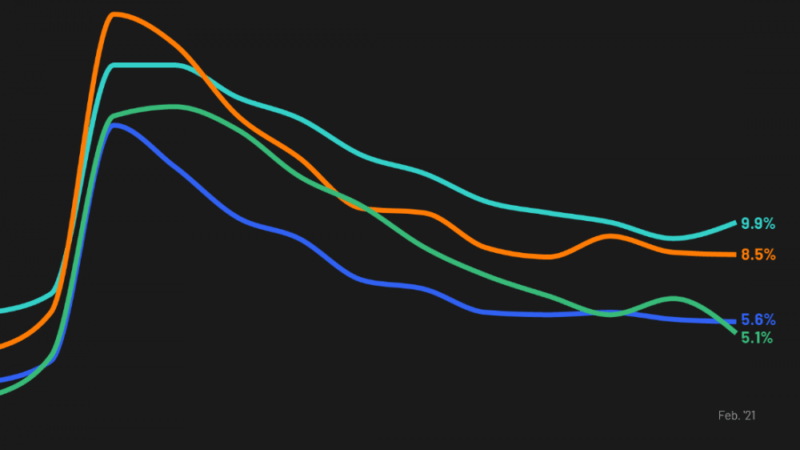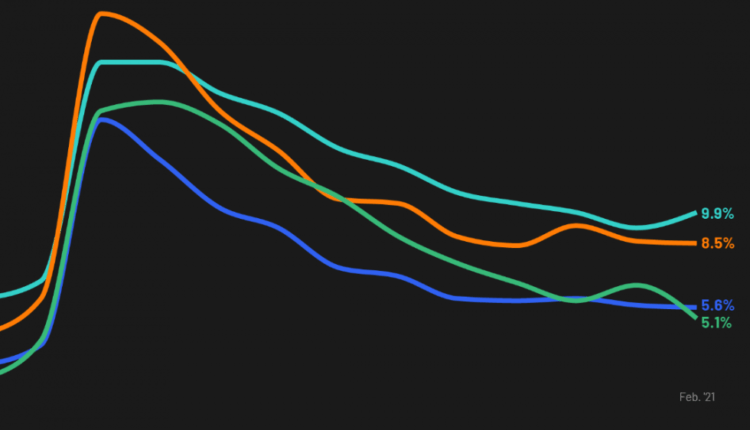New York (CNN Business)A year after the pandemic shut down the US economy, America’s workers are still hurting. For the past 12 months, first-time claims for jobless benefits have been higher than during the worst moments of the Great Recession.
Economists, politicians and workers alike are hoping that the continued vaccine rollout and warmer weather that allows more outdoor social activities will help the economy heal at a faster pace in the coming months.

These 5 charts show the pandemic's brutal impact on American workersBut, for now, improvements are still a bit harder to come by.
Last week, 770,000 Americans filed initial claims for unemployment benefits on a seasonally adjusted basis, the Department of Labor reported Thursday. It was an increase from the prior week and 70,000 claims more than economists had expected. It was also nearly 3 times as many claims as in the same week last year, just before the pandemic layoffs made benefit claims skyrocket.
On top of that, 282,394 filed for benefits under the Pandemic Unemployment Assistance program open to the self-employed and gig workers. Added together, more than 1 million people filed for first-time benefits last week, without seasonal adjustments.Read MoreContinued claims, which count people who have filed for benefits for at least two weeks in a row, stood at 4.1 million adjusted for seasonal swings.In total, more than 18 million American workers received benefits under the government’s various programs in the week ended February 27.
Where have the jobs gone?
Last spring, America shed more than 22 million jobs. Many of these people have been able to go back to work as the economy gradually reopened, but the nation still remains down 9.5 million jobs compared to February last year.Long-term unemployment is way up and economists worry that people who have lost their jobs and can’t find a way back will be permanently detached from the labor market.Kirsten Combs from Virginia is one of the workers who has been jobless throughout the pandemic. After being furloughed from her job as a general manager at optical retailer Visionworks last March, she was laid off in July.”This is an industry that was already struggling prior to the pandemic, and now stores are reducing staff size and payroll budgets to try to make up some of what they lost,” she told CNN Business. That’s why “jobs are scarce or salaries are much lower than they were before the pandemic, and I was already living paycheck to paycheck,” she said.”I guess I would just say I never imagined I’d be in a position like this and find myself unemployed for a year,” Combs added. “I’m so grateful for the stimulus and unemployment that has been provided to date, but it’s not enough.”
Help is on the way. The hurt remains
The latest stimulus package includes another round of stimulus checks for qualifying individuals, as well as an extension to pandemic unemployment benefits.Kim Mitcham from North Carolina was working in kids education for the Iredell County Partnership for Young Children until the pandemic hit, moving schooling online and ending a job she had for a decade.”I loved my job,” she told CNN Business. And even though she’s sent out dozens of copies of her resume, she’s still unemployed now.”I am depressed and anxious. And, I feel lost and lonely,” Mitcham said.The jobs crisis remains severe in some industries and demographic groups.Last month’s jobs report showed that while the White unemployment rate continued to improve, the jobless rate for Black Americans actually rose.
Sectors that rely on people coming together, such as hospitality and travel, are still hurting and so are the people who used to be employed in them.America’s labor market is still a long way from its pre-pandemic strength.
Source: edition.cnn.com

